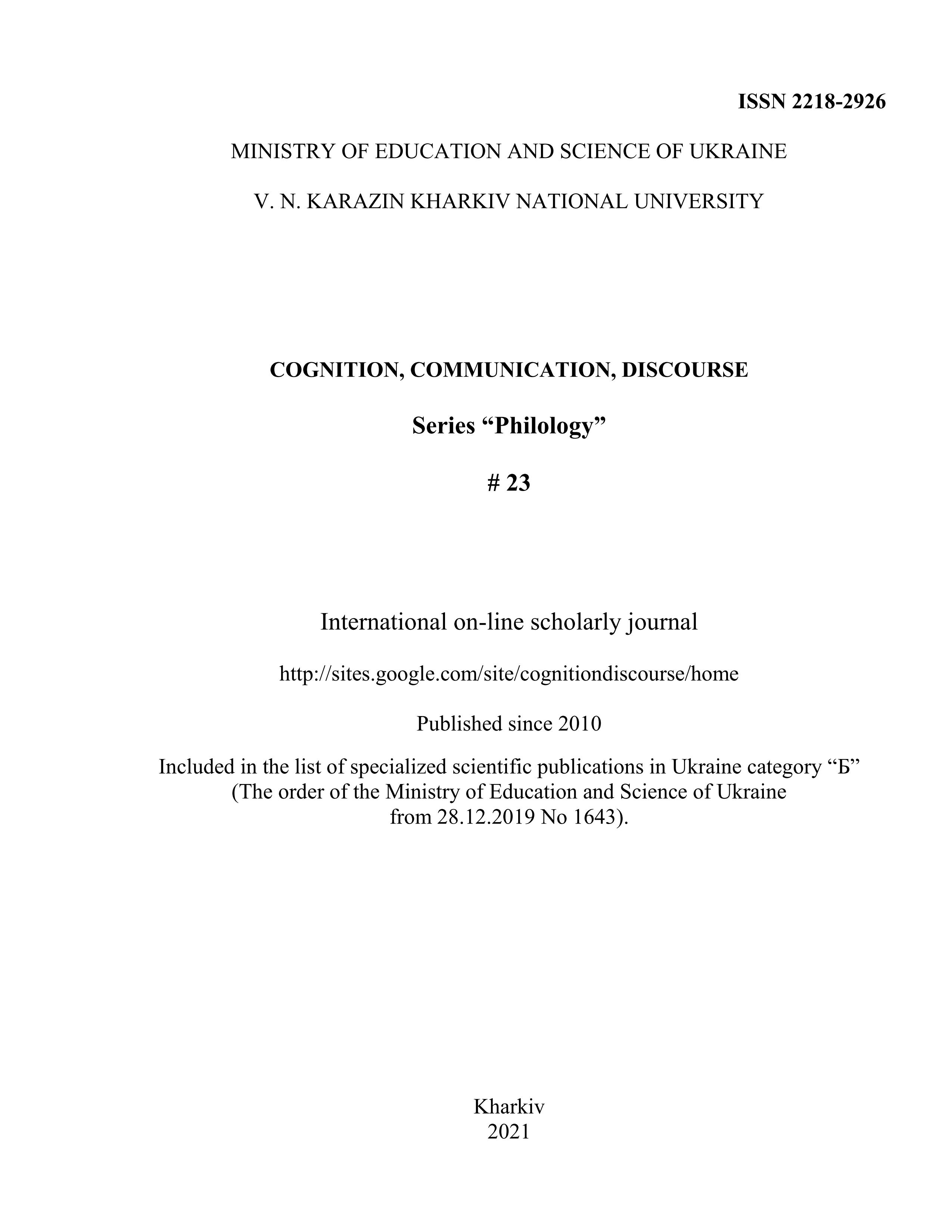Візуальна метафора в комерційній рекламі: ефективність чи невдача?
Анотація
Ґрунтуючись на сучасних підходах, дослідження фокусується на новому аспекті мультимодальної прагматики, виявляючи кореляцію між когнітивними та прагматичними особливостями візуальної метафори із залученням візуального граматичного аналізу, гіпотези оптимальної інновації, теорії концептуальної інтеграції, теорії релевантності і принципу кооперації. Метою статті є аналіз візуального повідомлення комерційної реклами у ракурсі оцінки його успішності/неуспішності відповідно до послідовно застосованих критеріїв “рівень метафоричної полісемантичності та неоднозначності”, “наявність відповідного контексту інтерпретації”, “рівень оптимальної інноваційності”. Дослідження дозволило дійти таких основних висновків. Перше. Візуальна метафора є відхиленням від однієї або декількох кооперативних максим, що є тригером дискурсивної імплікатури. Друге. Залежно від рівня імпліцитності і полісемантичності візуальної метафори результатом відхилення від кооперативних максим може бути як імплікатура, так і експлікатура. Якщо інференція імплікатури заплановане рекламним повідомленням, але вимагає від цільових адресатів надмірних зусиль для обробки візуальної інформації за відсутності відповідного контексту, рівень інтерпретації метафори обмежується експлікатурою. Третє. Рівні “експлікатури” та “імплікатури” у інтерпретації візуальної метафори пов’язані з різними ланками концептуальної інтеграції. Вилучення дискурсивної імплікатури, що, власне, становить інтендоване адресантом значення метафори, збігається з етапом нарощування (elaboration) бленду. Четверте. Залежно від балансу між рівнем впізнаваності та інноваційності компоненти візуальної метафори можна ранжувати за шкалою “привабливості / задоволення” для цільового клієнта – від оптимально інноваційних до чисто інноваційних.
Завантаження
Посилання
Bateman, J. (2014). Text and Image: A Critical Introduction to the Visual/Verbal Divide. Oxon: Routledge.
Beasley, R., & Danesi, M. (2002). Persuasive Signs: The Semiotics of Advertising. Berlin: Mouton de Gruyter.
Braun, S. (2016). The importance of being relevant? A cognitive-pragmatic framework for conceptualising audiovisual translation. Target, 28(2), 302-313. https://doi.org/10.1075/target.28.2.10bra
Carston, R., & Powell, G. (2006). Relevance theory: new directions and developments. In E. Lepore & B. Smith (Eds.), Oxford handbook of philosophy of language (pp. 341-360). Oxford: Oxford University Press.
Coulson, S., & Oakley, T. (2000). Blending basics. Cognitive Linguistics, 11(3-4), 175-196. https://doi.org/10.1515/cogl.2001.014
Dicerto, S. (2018). Multimodal pragmatics and translation: A new model for source text analysis. London: Palgrave Macmillan.
El Refaie, E. (2003). Understanding visual metaphor: The example of newspaper cartoons. Visual Communication, 2(1), 75-95. https://doi.org/10.1177/1470357203002001755
Fauconnier, G., & Turner, M. (2002). The way we think: Conceptual blending and the mind’s hidden complexities. New York, NY: Basic Books.
Forceville, C., & Urios-Aparisi, E. (2009). Multimodal metaphor. Berlin: Mouton de Gruyter.
Giora, R., Givoni, S., Heruti, V., & Fein, O. (2017). The role of defaultness in affecting pleasure: The optimal innovation hypothesis revisited. Metaphor and Symbol, 32(1), 1-18. https://doi.org/10.1080/10926488.2017.1272934
Giora, R, & Fein, O. (1999). On understanding familiar and less-familiar figurative language. Journal of Pragmatics, 31, 1601–1618. https://doi.org/10.1016/S0378-2166(99)00006-5
Giora, R (1998). When is relevance? On the role of salience in utterance interpretation. Revista
Alicantina de Estudios Ingleses, 11, 85–94. https://doi.org/10.14198/raei.1998.11.08
Gkiouzepas, L., & Hogg, M. K. (2011). Articulating a new framework for visual rhetoric in advertising: A structural, conceptual and pragmatic investigation. Journal of Advertising, 40(1), 103–120. https://doi.org/10.2753/JOA0091-3367400107
Grice, P. (1975). Logic and conversation. In P. Cole & J.L. Morgan (Eds.). Syntax and Semantics, 3. (pp. 41-58). New York, NY: Academic Press.
Grice, P. (1989). Studies in the way of words. Cambridge, MA: Harvard University Press.
Halliday, M. A. (1994). An introduction to functional grammar. London: Edward Arnold.
Jewitt, C., & Oyama, R. (2001). Visual meaning: A social semiotic approach. In T. Van Leeuwen & C. Jewitt (Eds.), Handbook of visual analysis (pp. 134-156). London: Sage. https://doi.org/10.4135/9780857020062.n7
Kravchenko, N., Goltsova, M., & Kryknitska, I. (2020). Politics as art: The creation of a successful political brand. Journal of History, Culture and Art Research, 9(3), 314-323. https://doi.org/10.7596/taksad.v9i4.2885
Kress, G., & van Leeuwen, T. (2006). Reading Images: The grammar of visual design. London: Routledge.
Kress, G. (2010). Multimodality: A social semiotic approach to contemporary communication. Oxford: Routledge.
Krysanova, T., & Shevchenko, I. (2021). Conceptual blending in multimodal construction of negative emotions in film. In A. Pawelec, A. Shaw, & G. Szpila (Eds.), Text-image-music: crossing the borders. intermediate conversations on the poetics of verbal, visual and musical texts. In honour of Prof. Elzbieta Chrzanowska-Kluczewska. Series: Text-Meaning-Context: Cracow Studies in English Language, Literature and Culture, 19 (pp. 357-371). Berlin: Peter Lang. http://doi.org/10.3726/b18012
Machin, D., & Ledin, P. (2020). Introduction to multimodal analysis. London: Bloomsbury Academic.
O’Halloran, K. (2004). Multimodal discourse analysis: Systemic functional perspectives. London: Continuum.
Shevchenko, I. (2019). Enactive meaning-making in the discourse of theatre and film. Cognition, communication, discourse, 19, 15-19. https://doi.org/10.26565/2218-2926-2019-19-01
Scott, L. (1994). Images in advertising: The need for a theory of visual rhetoric. Journal of Consumer Research, 21 (3), 252-273. https://doi.org/10.1086/209396
Schroeder, J. E. (2002). Visual consumption. London: Routledge. https://doi.org/10.4324/9780203471630
Toncar, M., & Munch, J. (2001). Consumer responses to tropes in print advertising. Journal of Advertising, 30 (1), 55-65. https://doi.org/10.1080/00913367.2001.10673631
Wilson, D., & Sperber, D. (2004). Relevance Theory. In L. Horn & G. Ward (Eds.), Handbook of pragmatics (pp. 607-632). Malden, MA: Blackwell.
Авторське право (c) 2021 Кравченко Наталія Кимівна, Юденко Олександр Іванович

Цю роботу ліцензовано за Міжнародня ліцензія Creative Commons Attribution-NonCommercial-NoDerivatives 4.0.
Автори, які публікуються у цьому журналі, погоджуються з наступними умовами:
Автори залишають за собою право на авторство своєї роботи та передають журналу право першої публікації цієї роботи на умовах ліцензії Creative Commons Attribution License (CC BY), яка дозволяє іншим особам вільно розповсюджувати опубліковану роботу з обов'язковим посиланням на авторів оригінальної роботи та першу публікацію роботи у цьому журналі.
Автори мають право укладати самостійні додаткові угоди щодо неексклюзивного розповсюдження роботи у тому вигляді, в якому вона була опублікована цим журналом (наприклад, розміщувати роботу в електронному сховищі установи або публікувати у складі монографії), за умови збереження посилання на першу публікацію роботи у цьому журналі.
Політика журналу дозволяє і заохочує розміщення авторами в мережі Інтернет (наприклад, у сховищах установ або на особистих веб-сайтах) рукопису роботи, як до подання цього рукопису до редакції, так і під час його редакційного опрацювання, оскільки це сприяє виникненню продуктивної наукової дискусії та позитивно позначається на оперативності та динаміці цитування опублікованої роботи (див. The Effect of Open Access).




